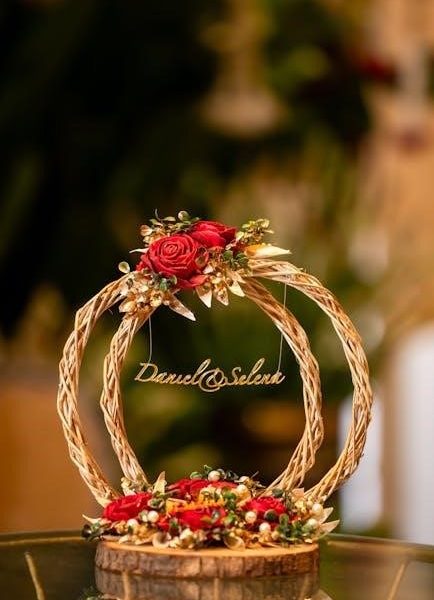
different types of roses with names and pictures pdf
Roses are timeless beauties, captivating gardens and cultures with their allure․ Their diverse types, from hybrid teas to wild species, showcase nature’s artistry and fragrance․
1․1 Brief History of Roses
Roses have captivated humanity for millennia, with ancient civilizations like Egyptians, Greeks, and Romans cherishing them for beauty and fragrance․ Their journey from wild species to cultivated hybrids began in the Middle East, with damask and centifolia roses becoming foundational for modern varieties․ Symbolism and cultural significance have enduringly shaped their allure in history and art․
1․2 Importance of Roses in Gardens and Culture
Roses hold profound cultural and symbolic significance, featuring in heraldry, art, and perfumery․ They symbolize love, beauty, and power, as seen in the Wars of the Roses․ In gardens, their vibrant blooms and fragrances make them central attractions, while their versatility in landscaping enhances both formal and informal spaces, captivating gardeners worldwide for centuries․
Hybrid Tea Roses
Hybrid Tea Roses are the most popular type, known for their large, single blooms on long stems․ Introduced in 1867, they offer vibrant colors and are ideal for exhibitions and cut arrangements․
2․1 Characteristics and Features
Hybrid Tea Roses are renowned for their large, single blooms on long stems, introduced in 1867․ They boast vibrant colors, repeat blooming, and are ideal for exhibitions․ These roses thrive in full sun and well-drained soil, making them a favorite for cut arrangements and garden displays․
2․2 Popular Varieties and Names
Popular Hybrid Tea varieties include ‘Peace,’ ‘Double Delight,’ and ‘Chrysler Imperial․’ These roses are celebrated for their striking colors, large blooms, and strong fragrances, making them favorites among gardeners and florists for their beauty and versatility in arrangements and garden displays․
2․3 Care and Maintenance Tips
Hybrid Tea roses thrive in full sun and well-drained soil․ Regular watering, deadheading spent blooms, and fertilizing during the growing season are essential․ Prune in late winter to maintain shape and promote healthy growth․ Protect from extreme weather and pests to ensure vibrant, continuous flowering․
Floribunda Roses
Floribunda roses are vibrant, cluster-flowering shrubs, combining the robustness of polyanthas with hybrid teas’ beauty․ Their colorful blooms and hardy nature make them ideal for dynamic garden displays and landscaping․
3․1 Origin and Development
Floribunda roses were developed in the 20th century by crossing Polyantha and Hybrid Tea roses․ They combine the robust, cluster-flowering nature of Polyanthas with the vibrant, large blooms of Hybrid Teas, creating a versatile and colorful shrub rose ideal for both gardens and floral arrangements․
3․2 Key Differences from Hybrid Teas
Floribunda roses differ from Hybrid Teas by producing clusters of blooms rather than single, large flowers․ They are more compact, bushy, and hardy, making them ideal for hedges or borders․ Floribundas are also more disease-resistant and require less maintenance, offering vibrant color and versatility in landscaping․
3․3 Best Varieties for Landscaping
Floribunda roses are ideal for landscaping due to their vibrant clusters of blooms and versatility․ Popular varieties like ‘Iceberg’, ‘Juliet’, and ‘Dainty Maid’ offer stunning displays of color․ These roses are perfect for hedges, borders, or mass plantings, adding beauty and vibrancy to outdoor spaces with minimal maintenance․

Grandiflora Roses
Grandiflora roses are known for their large, beautifully shaped blooms in over 100 colors, ideal for cutting and garden display․ A cross between Hybrid Teas and Floribundas․
4․1 Definition and History
Grandiflora roses are a cross between Hybrid Teas and Floribundas, known for large, double flowers in clusters․ Introduced in the 20th century, they combine the elegance of Hybrid Teas with Floribundas’ lush blooms, offering vibrant colors and repeat flowering, ideal for cutting gardens and wedding arrangements․
4․2 Popular Grandiflora Varieties
Grandiflora roses are popular for their large, shaped blooms and vibrant colors․ Notable varieties include the elegant ‘Queen Elizabeth’ and the striking ‘Gold Medal,’ both widely recognized for their beauty and fragrance, making them a favorite in gardens and floral arrangements․
4․3 Growing Conditions and Requirements
Grandiflora roses thrive in full sun and well-drained soil․ They require regular watering and balanced fertilization․ Protection from extreme temperatures and proper pruning are essential for optimal bloom production and plant health, ensuring their vibrant, large flowers continue to flourish beautifully in various gardening conditions․

English Roses
English roses, developed by David Austin, blend old-world charm with modern repeat-flowering traits․ Known for their lush, fragrant blooms and romantic appearance, they are a favorite in gardens worldwide․
5․1 David Austin Roses
David Austin roses, created by the renowned British rose breeder, combine the elegance of old garden roses with modern repeat-flowering traits․ These roses are celebrated for their lush, fragrant blooms and romantic, vintage appearance, making them a cherished choice for gardens seeking classic beauty and timeless charm․
5․2 Unique Features and Fragrance
David Austin roses boast strong, intoxicating fragrances reminiscent of old garden roses․ Their large, densely petalled blooms exude classic charm, while their robust scent adds to their allure․ This unique combination of beauty and fragrance makes them a favorite for both gardens and floral arrangements․
5․3 Popular English Rose Varieties
Popular English rose varieties include ‘Abbaye de Cluny,’ ‘Boscobel,’ and ‘Crocus Rose,’ known for their classic blooms and strong fragrances․ These roses, bred by David Austin, combine old-world charm with vibrant colors, making them ideal for gardens and floral arrangements․ Their timeless beauty captivates rose enthusiasts worldwide․

Knockout Roses
Knockout roses, introduced in 2000, are vibrant, low-maintenance roses known for their continuous blooms and hardiness․ They thrive in various conditions, making them a favorite for modern gardens․
Knockout Roses, introduced in 2000 by William Radler, revolutionized gardening with their vibrant colors and continuous blooming․ These low-maintenance roses quickly became popular for their hardiness and adaptability, making them a favorite for modern landscapes and lazy gardeners alike․
6․2 Low-Maintenance Care
Knockout Roses are renowned for their low-maintenance requirements․ They thrive with regular watering, minimal pruning, and full sun exposure․ Their self-cleaning blooms eliminate the need for deadheading, and their disease resistance reduces the need for pesticides, making them ideal for busy or novice gardeners․
6․3 Best Uses in Landscaping
Knockout Roses excel in hedges, borders, and container gardens due to their compact growth and vibrant blooms․ They add year-round color and texture, making them ideal for mass plantings or accentuating focal points in landscapes․ Their adaptability and consistent flowering make them a versatile choice for enhancing outdoor spaces of any style․

Climbing Roses
Climbing roses are vigorous, sprawling plants that add elegance to gardens․ They thrive on trellises, arbors, or walls, showcasing cascading blooms․ Their versatility and stunning displays make them a favorite for enhancing vertical spaces with beauty and fragrance․
7․1 Types of Climbing Roses
Climbing roses include various types like New Dawn, Clematis, and Ramblers․ They are versatile, thriving on trellises or arbors․ Popular varieties such as New Dawn and Clematis-inspired climbers offer vibrant blooms, while Ramblers provide cascading displays․ These roses add elegance and beauty to vertical spaces with minimal maintenance․
7․2 Training and Support Structures
Climbing roses require sturdy support structures like trellises, arbors, or fences to grow upright and showcase their beauty․ Train the stems by gently twining them around the structure or securing with ties․ Regular pruning and proper training ensure healthy growth and abundant blooms, making them a stunning garden feature․
7․3 Popular Climbing Rose Varieties
Popular climbing rose varieties include ‘New Dawn,’ known for its fragrant pink blooms, and ‘Climbing Iceberg,’ offering white, disease-resistant flowers․ ‘Fourth of July’ stands out with vibrant red and white stripes, while ‘Cecile Brunner’ delights with delicate pink blossoms․ These varieties thrive with proper support, adding elegance to any garden wall or arbor․
- New Dawn
- Climbing Iceberg
- Fourth of July
- Cecile Brunner
Miniature Roses
Miniature roses are small, delicate plants with tiny canes, foliage, and flowers․ They are ever-blooming, hardier than hybrid teas, and available in many colors, ideal for indoor growing․
8․1 Definition and Size
Miniature roses are small, compact plants with tiny canes, foliage, and flowers․ They are true roses, typically growing 6-18 inches tall, making them ideal for small gardens, containers, or indoor spaces․ Their diminutive size belies their vibrant colors and robust growth, offering a charming alternative to larger rose varieties․
8․2 Indoor and Outdoor Growing Tips
Miniature roses thrive in bright, sunny spots, whether indoors or outdoors․ For indoor growth, place them near a south-facing window․ Use well-draining soil and avoid overwatering․ Fertilize regularly during the growing season․ Prune lightly in spring or after blooming to maintain shape․ Protect from extreme temperatures for optimal health․
8․3 Popular Miniature Rose Varieties
Popular miniature rose varieties include ‘Margo Koster’, ‘The Fairy’, ‘China Doll’, ‘Cecile Brunner’, and ‘Perle dOr’․ These compact roses offer vibrant colors and delicate blooms, making them ideal for small gardens or indoor containers․ Their charm and versatility have made them favorites among rose enthusiasts worldwide․
Species Roses
Species roses are wild, natural roses unaltered by hybridization, offering simple, single-petaled blooms․ Hardy and low-maintenance, they thrive in diverse environments, embodying raw beauty and resilience in gardens worldwide․
9․1 Wild Roses and Their Characteristics
Wild roses, or species roses, are naturally occurring plants with simple, single-petaled blooms․ They are hardy, low-maintenance, and often have five petals․ These roses thrive in diverse environments, offering vibrant colors and attracting pollinators․ Their resilience and natural beauty make them ideal for gardens seeking an untamed, authentic aesthetic․
9․2 Hardy and Low-Maintenance Varieties
Species roses, such as Rosa rugosa and Rosa virginiana, are exceptionally hardy and require minimal care․ They thrive in diverse conditions, tolerating drought and cold, and are resistant to pests․ Their resilience and simple beauty make them ideal for low-maintenance gardens, offering a natural, unspoiled charm without the need for constant attention․
9․3 Growing Wild Roses in Your Garden
Growing wild roses like Rosa rugosa or Rosa virginiana is straightforward․ They prefer well-drained soil and full sun, tolerating drought and cold․ Plant them in open areas for natural growth, water sparingly, and avoid excessive pruning․ Their hardiness and simplicity make them perfect for creating a rugged, charming landscape with minimal care required․
Damask Roses
Damask roses are renowned for their intense fragrance and historical significance․ Originating in the Middle East, they have been cultivated since antiquity, valued for their scent in perfumes and oils․
10․1 History and Fragrance
Damask roses, deeply rooted in ancient Middle Eastern culture, are celebrated for their potent, sweet fragrance․ Historically, they’ve been used to create perfumes and attar, with their scent symbolizing love and luxury in Greek and Roman traditions․
10․2 Uses in Perfumes and Attar
Damask roses are highly valued for their intense fragrance, often used in perfumes and attar production․ Their essential oils are extracted through steam distillation, creating luxurious scents for the perfume industry․ This centuries-old practice highlights their significance in aromatherapy and cosmetic applications․
10․3 Popular Damask Rose Varieties
Popular Damask rose varieties include Rosa damascena and Rosa gallica, known for their robust fragrance․ Varieties like ‘Kazanlak’ and ‘Zmeuri’ are prized for their essential oils․ These roses are cherished in gardens and perfumery, offering timeless beauty and scent․
Shrub Roses
Shrub roses are modern, hardy, and low-maintenance, offering vibrant blooms and dense foliage․ They are ideal for hedges and landscaping, providing year-round beauty with minimal care․
11․1 Modern Shrub Roses
Modern shrub roses are tough, beautiful, and free-flowering, ideal for landscaping․ They offer vibrant blooms, dense foliage, and excellent disease resistance․ These versatile roses are perfect for hedges or ground cover, requiring minimal upkeep while adding lasting beauty to any garden setting․
11․2 Hardy and Disease-Resistant Varieties
Modern shrub roses are renowned for their resilience and resistance to diseases․ Varieties like ‘The Fairy’ and ‘Cecile Brunner’ thrive with minimal care, making them perfect for gardeners seeking durable, low-maintenance plants․ Their robust nature ensures they flourish in various conditions, providing vibrant blooms season after season․
11․3 Best Shrub Roses for Hedges
Shrub roses like ‘Margo Koster’ and ‘China Doll’ are ideal for hedges due to their compact growth and vibrant blooms․ Varieties such as ‘Perle dOr’ offer dense foliage and continuous flowering, making them perfect for creating stunning, fragrant hedges that add beauty and structure to any garden landscape․
Roses offer unmatched beauty and variety, making them a timeless garden favorite․ Proper care, including sunlight, watering, and pruning, ensures thriving plants․ Explore and plant roses to enjoy their elegance and fragrance year-round․
12․1 Summary of Rose Types
Roses come in diverse forms, from classic Hybrid Teas and vibrant Floribundas to elegant English Roses and low-maintenance Knockouts; Climbing Roses add vertical beauty, while Miniature Roses charm with their compact size․ Species Roses and Damask Roses offer wild charm and fragrance, with Shrub Roses and Grandifloras completing the spectrum of beauty and diversity․
12․2 General Rose Care and Maintenance
Proper rose care involves planting in well-drained soil with sunlight, watering deeply, and feeding regularly․ Pruning promotes health and blooms, while mulching retains moisture․ Protecting from pests and diseases ensures longevity․ Regular grooming and seasonal check-ups help maintain vibrant, thriving roses in any garden setting․
12․3 Encouragement to Explore and Plant Roses
Exploring the diverse world of roses offers endless possibilities for gardeners․ With so many types to choose from, planting roses can enhance any space, bringing beauty, fragrance, and joy; Whether you’re a novice or an expert, roses promise a rewarding experience․ Start small, experiment with varieties, and enjoy the journey of growing these timeless flowers․
Leave a Reply
You must be logged in to post a comment.